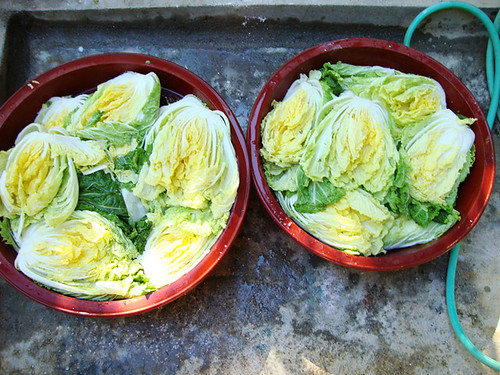I'm just listening to music and semi-relaxing. My mom and I did make kimchi. Unfortunately, my hands were occupied, so I wasn't able to take pictures of the "real process" Instead, here's a picture of the cabbages sitting in a salt brine.
15 cabbages in all.
We started around 2:20PM and finished around 1AM. It's cause the brining part took so long!
Unfortunately, I don't have an exact recipe with measurements to share because we don't really measure anything, we just kind of eye it. The measurement of each ingredient also really depends on personal taste and how much kimchi you want to make at a time. We made kind of a lot. You may just want to start out smaller with 2 or 3 cabbages.
But these are just the steps you go through when making kimchi. Oh yes, and I'd recommend that you use some gloves if you don't want stained hands with burning sensations! :P
배추 김치 (bae-chu kim-chi)
Ingredients:
Napa Cabbage
Korean radish
Coarse sea salt
Garlic
Ginger
Green Onions
Fish sauce
Mochiko Powder
Red Pepper powder
Salt
Sugar
Raw oysters or shrimp
Water
1. Cut the cabbage in half and give it a dip in water. If the cabbage is very big, you can quarter them. (You don't need to wash it at this point, because you will wash it after it's been sitting in the salt brine)
2. Lift each leaf and sprinkle each individual leaf with coarse sea salt. The quick dip in the water will allow the salt to stick to the leaves. After you're done doing this for all the cabbages, put them in a large container with salted water. (Don't fill the container up to the brim with the water, just about half way) Let them sit in this brine for several hours. The cabbage will reduce in volume and turn darker in color. Remember to turn over the cabbages once in between so that they all get evenly covered in the salt brine.
3. In a medium saucepan, pour in mochiko powder (sweet rice flour) with water and simmer until the mixture turns into a thicker transluscent paste. Stir continuously to take out all the lumps and so the mixture doesn't burn onto the pan. Take it off the stove when it starts to boil.
4. After the mixture cools, stir in red pepper powder, salt, sugar, freshly minced garlic, minced ginger, and fish sauce. Incorporate well.
5. Once the cabbages are ready, rinse them under running water several times. About 3~4 times should do the trick. Drain the cabbages and give them a little squeeze.
6. Julliene some Korean radish and roughly chop some green onions and transfer them into a large container. Pour in the red pepper mixture and toss the ingredients together.
7. You can also add in chopped raw oysters or shrimp if you'd like. My mom makes it with raw shrimp. But if you feel uneasy about this, just omit it altogether. It's optional.
8. Mix all the ingredients together. Now spread the red pepper mixture thoroughly over the cabbage. Don't forget to lift each leaf and give it all a good coating with the mixture. Repeat this step for all the remaining cabbage.
9. Place the cabbages in a air tight contain or a glass jar.
You can eat it fresh or fermented, depending on what you prefer. To ferment, keep it in room temperature for 1 or 2 days, before transferring into the refrigerator/kimchi refrigerator. (Kimchi stays fresher longer in a kimchi refrigerator.) You will know if the kimchi is fermented when you open the container and see bubbling liquid and it smells sour. Also, don't fill the container or jar up to the very brim because it'll most likely leak juices while it ferments. And as you know kimchi stains are hard to get rid of.
I'm sorry that I couldn't provide any measurements.


2 comments:
Thank you! I'm going to try it! We have several Asian groceries in the area, so I will look for the Korean radish, fish sauce and Mochiko powder. Yummy!
Thank you, Grace! I'm going to try it as well. Or, maybe I should just go to the Korean market and buy some already made. I wonder if it would be any good. It looks like a lot of work!
Post a Comment